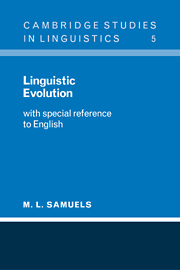Book contents
- Frontmatter
- Contents
- Preface
- Note to second impression
- Abbreviations
- 1 Introduction
- 2 Variation in the spoken chain
- 3 System: the phoneme
- 4 Grammar and lexis (I): variation
- 5 Grammar and lexis (II): systemic regulation
- 6 Diversity and contact
- 7 An assessment of the problem
- 8 Dimensions of study
- 9 Conclusions
- Bibliography
- Index of persons
- Index of subjects
- Plate section
4 - Grammar and lexis (I): variation
Published online by Cambridge University Press: 05 June 2012
- Frontmatter
- Contents
- Preface
- Note to second impression
- Abbreviations
- 1 Introduction
- 2 Variation in the spoken chain
- 3 System: the phoneme
- 4 Grammar and lexis (I): variation
- 5 Grammar and lexis (II): systemic regulation
- 6 Diversity and contact
- 7 An assessment of the problem
- 8 Dimensions of study
- 9 Conclusions
- Bibliography
- Index of persons
- Index of subjects
- Plate section
Summary
Introductory
The distinction between grammar and lexis is decided, for synchronic purposes, by various conflicting criteria, though it is usually possible to define some practical boundary. But no grammatical system is ever ideally ‘complete’, and therefore the boundary must be regarded as one that shifts in time. Meaning is carried by both grammar and lexis, and all meanings can be expressed primarily by one or the other, though often by devious circumlocution or expedient. Grammar is a selection of short-cutting devices for a certain number of the commonest functions, not for all. But since speakers are obliged by convention to use these devices even where the utterance, if spoken under ideal conditions, would not strictly need them (e.g. -s in he goes), grammar provides the language with a built-in level of redundancy that could not be achieved lexically, e.g. in the case just quoted it would serve to distinguish he go from we go if conditions for receiving the message were not ideal. But provided that that level is maintained, the actual choice of functions to be expressed grammatically may vary, not only from one language to another but also from one stage to another of the same language; at any given stage, the remaining functions are then expressed lexically, or left to be deduced from the context.
Thus in individual contexts it may appear that more is ‘taken for granted’ in one language than in another, e.g. Italian ha compared with British English have you got, American English do you have. But that is only one context where such brevity is permitted by the system of Italian.
- Type
- Chapter
- Information
- Linguistic EvolutionWith Special Reference to English, pp. 49 - 63Publisher: Cambridge University PressPrint publication year: 1972

